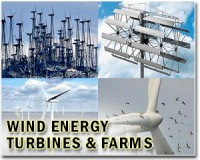 |
College Park, MD (SPX) Oct 28, 2010 Offshore wind power offers a feasible way for Maryland to help meet its renewable energy goals, but presents some economic and political hurdles, concludes a new study by the University of Maryland Center for Integrative Environmental Research (CIER). Maryland Offshore Wind Development, is the most in-depth feasibility assessment to date of developing and operating wind farms in Maryland's Atlantic coastal waters, the researchers say. Among the study's key findings, offshore wind development will have to address two serious hurdles to move forward: Likely interference with the NASA Wallops radar installation, as well as military operations; Inadequate transmission facilities on Maryland's Eastern Shore that would raise the cost of moving the energy produced to the utility grids; this could be accomplished most economically in Delaware. "Offshore wind is not a slam dunk for Maryland, but the potential remains very strong," says principal investigator Matthias Ruth, a University of Maryland public policy professor and CIER director. "It's economically feasible and environmentally advantageous, but will require some tough trade-offs, compromise and collaboration between public and private sectors."
Recent Developments Subsequently, the Maryland Energy Administration, with input from the Department of Natural Resources, commissioned the CIER study, including an economic comparison of the relative merits of shallow vs. deep water locations for the turbines. Ruth adds that recent developments since the report's completion may add to the potential benefits of offshore wind: Uncertainty surrounding development of a new nuclear reactor in Calvert County (Calvert Cliffs), which he says makes it more important to consider other potential renewable sources of electric power, including offshore wind. Proposal by a Google-led investment group could enhance prospects for distributing electricity generated by Maryland offshore wind farms, he says. The Google group would create a transmission network connecting such facilities at various points along the eastern seaboard. "The technology is known and proven, especially in Europe, to be clean and cost-effective," Ruth concludes. "Compared to any alternative, this is a low risk addition to our energy portfolio." "The impediments are not technical, they are institutional," adds co-investigator Andrew Blohm, a CIER researcher. Ultimately, overcoming the hurdles will require close collaboration between Maryland, Delaware and the federal government."
Specific Findings "Not only would offshore wind development help Maryland meet its renewable energy goals, but it would also provide ancillary benefits, such as jobs and industry development, and further position the state as an environmental first mover," Ruth says. Interconnecting with the Utility Grid: Delivering energy produced by wind turbines in Maryland waters to the electric utility grid could be accomplished most economically in Delaware. Previous studies found that connecting to the grid near Ocean City, Md. would cost an estimated ten times more than at Bethany Beach, De. - about $200 million vs. $20 million. "A difference of only twenty miles raises costs ten-fold," Blohm explains . "On the Delmarva Peninsula, the Delaware side of the state line has a more fully developed, and in this case, a more strategically located electric transmission system than Maryland's Eastern Shore." While this does not prevent placement of offshore wind facilities in Maryland waters, it does complicate the interconnection process and may require a more regional approach to development, Blohm adds. Radar and Military Interference: Of the mid-Atlantic radar facilities that might experience interference from the turbines, "the potential for diminished radar functionality exists at NASA's Wallops Flight Facility," the study reports. This is used by several agencies, including the Federal Aviation Administration, NASA and the U.S. Navy. "It's a huge hurdle, but this does not have to be a make-or-break issue." says co-investigator Sean Williamson, a CIER researcher. "Collaboration with the U.S. military and other users could reconcile any conflicts - if the parties are willing to compromise." Additional conflict with U.S. military operations is likely to involve mobile radar units on planes and ships, as well as flight-testing, training exercises and munitions deployment. Placing Turbines in Shallow vs. Deep Waters: The overall cost of developing and operating wind turbines in shallow or in deep waters off Maryland's coast would be about the same - roughly $1,850 per kilowatt, the study finds. "Turbines in deeper waters may be better positioned to capture more wind energy, but transmission costs are higher," adds co-investigator Yohan Shim, a CIER researcher. Ultimately, the study finds that either location would be about the same in terms of economic feasibility.
Share This Article With Planet Earth
Related Links University Of Maryland Wind Energy News at Wind Daily
 Google blows into offshore wind project
Google blows into offshore wind projectWashington (UPI) Oct 15, 2010 Google has agreed to invest, along with other partners, in a massive offshore wind power project along the U.S. Mid-Atlantic region. The Atlantic Wind Connection "backbone" deep-water cable transmission project, led by Trans-Elect, is expected to provide approximately 6,000 megawatts of offshore wind capacity, enough power to serve 1.9 million households, when fully complete. Oth ... read more |
|
| The content herein, unless otherwise known to be public domain, are Copyright 1995-2010 - SpaceDaily. AFP and UPI Wire Stories are copyright Agence France-Presse and United Press International. ESA Portal Reports are copyright European Space Agency. All NASA sourced material is public domain. Additional copyrights may apply in whole or part to other bona fide parties. Advertising does not imply endorsement,agreement or approval of any opinions, statements or information provided by SpaceDaily on any Web page published or hosted by SpaceDaily. Privacy Statement |